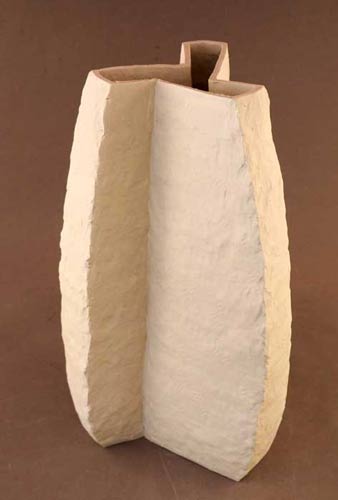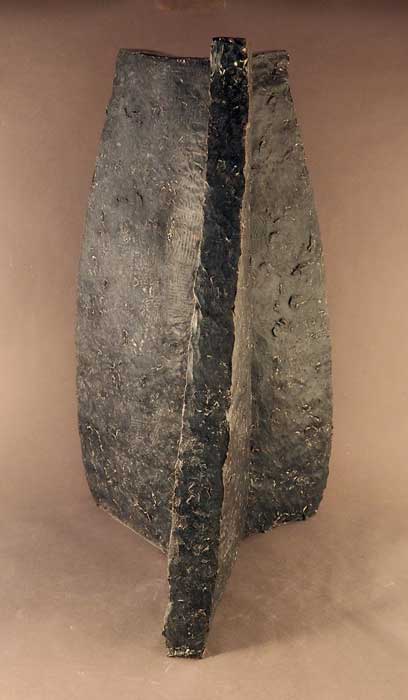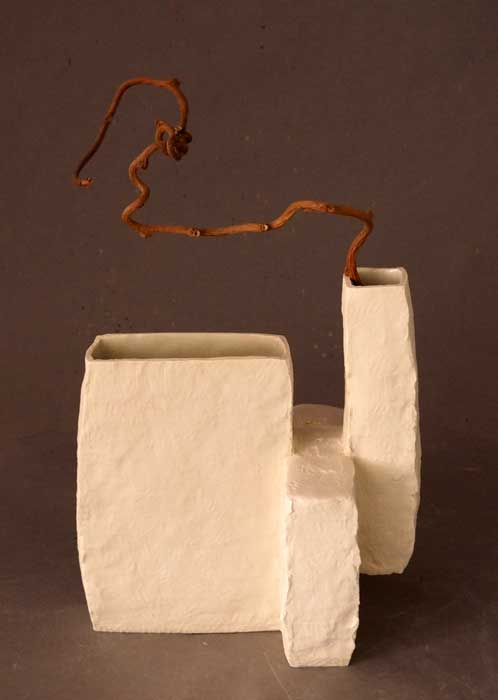V: So, Francesc, at the show delivery the other day, I overheard you explaining that the forms you built were coil, not slab, as the patron had assumed. I realized that I had assumed that, as well, so I want to ask you further about using the coil technique for building such large, architectural-type forms. What can you tell me about that?
F: I’ve done a fair amount of slab construction, but it has two problems (for me) 1) the joints are inherently weak points, relative to the rest of the piece, and 2) clay slabs are either stiff, requiring straight edges, or else, if you want curved surfaces, they need to be still soft, which makes assembly much more difficult since they don’t stand up. Coil-building was an early way of making ceramic vessels, traditionally round, before the invention of the potters wheel; you place coils of clay, successively, one on top of the previous one and join them. It is time consuming but allows great flexibility of possible forms and the piece has no weak points since the edges are continuous.
V: A show you had a few years ago had work with terra sigillata featured as a surface treatment. Do you have work in this current show with surface treatments you are excited about?
F:Surface finish is an aspect that I have yet to be happy with. All the pieces in this show have a final coat of terra sigillata, although the tag info doesn’t mention, or is listed as “slip”, terra sig. being a very fine clay slip, colored or not. Some pieces in this show have white glaze details, and in some pieces the glaze has been sand-blasted after firing.
V: Each time I have a show, I feel this rush toward the end of the production phase where new ideas just keep coming and I start hitting on some things that I wish I’d hit on earlier in the process. Does this ever happen to you as you prepare for a show?
F:Absolutely, the ideas executed for this show are but a fraction of a multitude generated in the past months on related subjects, and not necessarily the best. Something to look forward in future work
V: Working in clay, it’s not like painting in acrylic…..where you can just paint up until the night before the show drop-off. How do you organize your time to make sure your work is done well beforehand so there’s time for drying, firing, etc.?
F: Well, it just takes planning, and ingenuity. Working with ceramics you need to be patient, the work must dry slowly, and in the humid climate of the mid-west that can test your patience, or it tries mine. You first fire the piece to low temperature, bisque, to give it strength, then glaze it, then fire it again to maturing temperature; the whole process can easily take several weeks. As the deadline approaches, I have resorted to different shortcuts, pieces that are finished at bisque temperature, or pieces that don’t require glazing and can be fired directly to maturing temperature, skipping bisque firing; or, as a last minute resort, doing site-specific installations with non-ceramic materials, like in this show.
V: Last question…..you’re trained as an architect and as a ceramicist. What about these two disciplines crosses over for you and what is just so different that it stays firmly in either the ‘architecture’ or ‘ceramics’ discipline?
F: The best answer to your last question is a quote from my artist statement:
“Ceramics has been, since prehistory, about vessels. As a sculptor and ceramist I am interested in natural and human-made forms that contain, protect and shape life in its multiplicity of form; a hard wall around a hollow space: shells, hulls, buildings… I am interested in the relation between interior and exterior space, and inspired as well by music and geometry. I aim for forms that will have a strong presence and be intriguing and beautiful, proportionate and harmonic inside and out: the poetics of space.”


